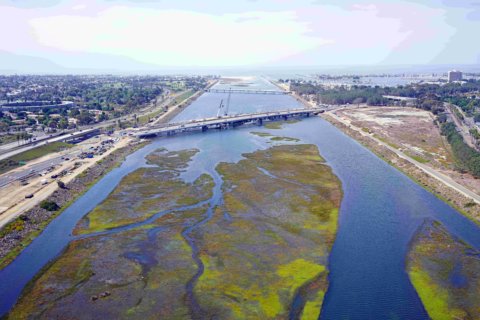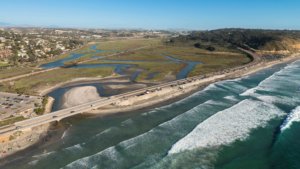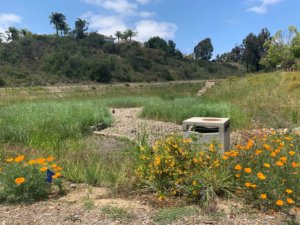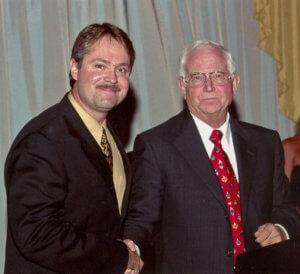
By the mid-1970s, RICK had established itself as a trusted firm in San Diego, and the next decade brought new challenges and opportunities that pushed the company to expand. Development across California was accelerating, with regulations becoming more complex and clients asking for broader expertise.
RICK took the opportunity to grow, creating new divisions and establishing its first office outside of San Diego.
One of the most significant milestones in 1978 was the creation of the Water Resources Division. Led by former RICK Principal Dennis Bowling, the team began in response to the 1972 Clean Water Act and a rising demand for specialized hydrology and hydraulics engineering. At the time, San Diego was quickly experiencing development that required new approaches to drainage and flood control along with stronger water quality measures. The new division allowed RICK to more efficiently design storm drain systems and detention and desilting basins, as well as to support agencies with floodplain and stormwater needs. Early assignments included floodplain analysis in Kern County, hydrologic studies for the San Dieguito River, and planning work in new communities such as Carmel Valley and North City West. It was technical engineering work, but the results protected neighborhoods from flooding while helping communities meet FEMA’s National Flood Insurance Program requirements.

“The demand for hydrology and hydraulics was rising fast, and we knew we needed a division dedicated to it. That’s how Water Resources began, and it has shaped so much of what we do.” —Dennis Bowling, Former RICK Principal
 The launch of Water Resources reflected a growing emphasis on innovation. The team adopted new modeling tools, such as HEC-1, and began experimenting with early GIS applications while also taking on watershed studies that were starting to guide regional planning. This gave RICK a technical advantage when cities were just starting to require drainage master plans. The division’s work soon tied into high-profile developments, such as Fairbanks Ranch, where stormwater and floodplain planning played a critical role in supporting the community and planning for the San Dieguito River Park.
The launch of Water Resources reflected a growing emphasis on innovation. The team adopted new modeling tools, such as HEC-1, and began experimenting with early GIS applications while also taking on watershed studies that were starting to guide regional planning. This gave RICK a technical advantage when cities were just starting to require drainage master plans. The division’s work soon tied into high-profile developments, such as Fairbanks Ranch, where stormwater and floodplain planning played a critical role in supporting the community and planning for the San Dieguito River Park.
In 1984, RICK opened an office in Phoenix, the company’s first step outside California. It was a chance to grow in a new environment while continuing the work that had built RICK’s name in San Diego. Arizona was a different environment with new expectations, and its rapid growth brought a steady stream of projects. Several RICK employees used the opportunity to relocate and be part of expanded leadership positions in the company.
“Phoenix is a chance to grow while keeping the same quality and relationships that built our name in San Diego.” —Lyle Gabrielson, Former RICK President

The Phoenix office quickly became an essential part of RICK’s work across the Southwest. Within months, the office was taking on projects in land use planning, civil engineering, drainage studies, and surveying, all with the same expertise that built RICK’s reputation in California. Employees were involved in subdivision design and infrastructure planning in support of new master-planned communities across Arizona. For the team, Phoenix represented an opportunity to expand their own experience while strengthening RICK’s presence in a new market.
This period also brought a major change in leadership. In 1984, Lyle Gabrielson became the president, taking on a role that had been carefully planned with Bill Rick to ensure a smooth transition. The move was part of an effort to share responsibility across the company and prepare for the future. Gabrielson’s leadership gave staff the confidence that RICK could expand while staying true to its culture.
“This is a personal service business, no matter how large we get. What matters is doing the work well and standing behind it.” —Bill Rick, Former RICK President

By the end of the decade, RICK had grown to about 150 employees. The creation of Water Resources positioned the company to handle complex floodplain studies and master drainage plans, work that soon appeared in projects like the Carmel Valley Precise Plan and the San Dieguito River Studies.
Phoenix soon became a strong presence of its own, showing that RICK could establish itself in a new market outside California.
RICK’s expansion changed the types of work it could take on. Early adoption of tools like HEC-1 and GIS gave the firm a technical advantage, while Water Resources was already shaping communities through floodplain analysis and watershed planning. By 1985, the company had built the foundation to take on more complex projects across the Southwestern US that would define the decades ahead.
As part of our 70th anniversary series, we’ll continue sharing the history and growth that have shaped RICK over the decades. Watch our news feed for future articles as the story of RICK’s history unfolds.